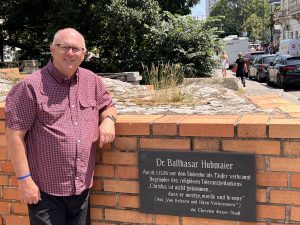
Some events are so significant, so shaping of history, that their dates deserve to be remembered. The Protestant Reformation was such an event, and when its five hundredth anniversary arrived, the Christian world buzzed with reflections on its significance. (I contributed an article of my own to that discussion.)
There is something about acknowledging a milestone anniversary that makes the people and events of that moment seem more real. Their choices, their sacrifices, their courage are not just remembered; they become more connected to our own lives.
That’s what happened for me earlier this year as I read The Anabaptist Story by William Estep and realized that 2025 marks five centuries since the birth of the Anabaptist movement.
If you are a student of Baptist history, you know the story. On January 21, 1525, a small group gathered in Felix Manz’s home in Zürich, Switzerland, to submit themselves to believers’ baptism. Their leaders—Felix Manz, Conrad Grebel, and George Blaurock—set the example. Grebel baptized Blaurock, who then baptized the others present. It was an act of conscience, obedience, and courage—a moment so much larger than they could have imagined. And it cost them more than most of us can easily comprehend.
Although groups that believed and practiced the New Testament doctrines that the Anabaptists stood for predated and succeeded the sixteenth-century Anabaptists, their courage, conviction, and martyrdom is a powerful chapter in Baptist history.
But why has this five hundred year anniversary gone overlooked? And what significance does it have to Bible-believing Baptists today?
Why Should We Remember the Anabaptists?
The story of the sixteenth-century Anabaptists is a story written in blood. For their belief in and practice of believers’ baptism, they were persecuted, tortured, and put to death.
Unlike the Reformers, however, the Anabaptists were not persecuted only by hostile governments. They often suffered at the hands of the Reformers themselves.
For instance, Felix Manz was the first Anabaptist martyr to be executed by the Reformers—at the order of Zwingli’s council in Zürich. Conrad Grebel died of illness after years of hardship brought on by persecution. George Blaurock was whipped out of Zürich (literally chased out with a whip), made his way across Europe preaching the gospel, and in 1529 was burned at the stake in Tyrol. And that’s just three out of thousands.

This plaque in Vienna marks Conrad Grebel’s years of study in Austria (1515–1518), where his education prepared the mind God would later use to study Scripture and ignite the Anabaptist movement.
Why? What was so threatening about believers’ baptism that both political and religious leaders would persecute those who practiced it?
The answer lies in the union of church and state that began with Constantine in the fourth century and, even during the Reformation, defined sixteenth-century Europe. In the state churches (including the Lutheran and Reformed churches, and later the Anglican Church in England), baptism was applied to infants as both a civic and religious rite, making every newborn a member of the church and a subject of the state. Churches themselves were under the headship of the state and, based on infant baptism, were filled with unregenerate members who never made a personal decision of faith in Christ.
In reading Scripture, however, the Anabaptists discovered not only the absence of infant baptism, but the unmistakable presence of believers’ baptism. (See Acts 2:41, 8:36–38.) They insisted that baptism must follow personal faith in Christ. For that, they were branded “Anabaptists,” or “re-baptizers.” Their enemies meant it as a slur, but the name stuck.
As important as believers’ baptism is, the Anabaptists were standing for more than baptism alone. The larger doctrines impacted by this conviction related to the authority of Scripture (not tradition) as the final rule of faith and practice, Christ (not the state) as the head of the church, and the New Testament pattern of local churches comprised of saved, baptized believers. (See 2 Timothy 3:16–17, Colossians 1:18, Acts 2:41–42, 1 Corinthians 1:2, and Titus 1:5.)
To be sure, the Reformation was not without its spiritual help and historical significance. God undoubtedly used the Reformation to bring the Word of God and the gospel itself to the forefront. One author has even described it as “rescuing the gospel.” But if the Reformers rescued the gospel to make it accessible once again, the Anabaptists rescued the New Testament church.
The Anabaptists’ convictions were not innovations of the sixteenth century. In fact, the Anabaptists themselves believed they were simply practicing the New Testament doctrine of the apostles. A simple reading of their written works repeatedly emphasizes this.
The apostles, according to the command of the Lord, through the preaching of the gospel, in faith and truth and by proper Christian baptism, and the power and unity of the Holy Spirit, gathered a church out of all nations (Matthew 28:19–20, Mark 16:15–16).—Dirk Philips (Dutch Anabaptist)
From the first century onward, God has preserved His truth through Bible-believing Christians and faithful local churches. Many of their names are unknown to us, hidden by time and persecution. Others, like the Anabaptists, left a clearer record. Throughout the centuries, there have always been believers who, though sometimes differing in individual doctrines, held firmly to the authority of Scripture, the headship of Christ, and the necessity of a regenerate church. And like the Anabaptists, many sealed those convictions with their own blood.
I’ve had the privilege of visiting many of the historic sites related to the Anabaptists and contemplating the sacrifices they made for fidelity to Christ and His Word. Their courage and conviction continue to challenge us to stand. With that in mind, I introduce you to a few of these leaders:
Felix Manz (1498–1527)
Felix Manz was one of the earliest leaders of the Swiss Brethren and was the first Anabaptist to be martyred at the hands of the Reformers. Originally a supporter of Ulrich Zwingli in Zürich, Manz wanted to take the principle of sola Scriptura (Scripture alone) to its biblical conclusions. Specifically, he called for the Mass to be abolished and for believers’ baptism to be practiced.

Set into a wall beside the Limmat River in Zürich, this marker reads: “Here in the middle of the Limmat, Felix Manz and five other Anabaptists were drowned during the Reformation period between 1527 and 1532. The last Anabaptist to be drowned was Hans Landis, executed in 1614.”
On January 21, 1525, Manz opened his home for the meeting in which those first baptisms mentioned above took place. Manz became a bold preacher of the gospel and an outspoken advocate of believers’ baptism as he preached and baptized believers across Switzerland.
For his convictions, the Zürich council condemned Manz to death. On January 5, 1527, Manz was led to the River Limmat, tied hand and foot, and drowned. As he was brought to the water, he praised God and sang psalms. His martyrdom, tragically ordered by the Reformer Zwingli, sealed with blood the Anabaptist conviction that Christ—not the state—rules His church.
Balthasar Hubmaier (1480?–1528)
Trained as a Catholic theologian, Balthasar Hubmaier became one of the most articulate voices of the Anabaptist movement. A gifted writer and preacher, he spread the Anabaptist message throughout Switzerland, Germany, and Moravia. His written works include Concerning Heretics and Those Who Burn Them, in which he argued that faith cannot be coerced (by the state or anyone else) and that heretics must be won through Scripture, patience, prayer, and witness.
Hubmaier insisted that baptism was a public confession of personal faith, declaring, “You must ask the Scriptures, not the church.” Hubmaier’s evangelistic preaching was fruitful, and it is said that in one city alone six thousand people were baptized through his ministry. His wife, Elisabeth, stood faithfully beside him through persecution.

Near Vienna’s Stubentor stands a memorial at the site where Dr. Balthasar Hubmaier was burned as an Anabaptist on March 10, 1528. It reads: “Christ did not come that I should kill, burn, and murder.”—from On Heretics and Those Who Burn Them
I’ve used his oft-repeated line, “Truth is immortal,” as the title for this article. It captures the heart of his convictions as well as his hope in God that even when he was gone, the truth would live on.
In March 1528, Hubmaier was burned at the stake in Vienna, crying out, “O Jesus, Jesus!” as the flames consumed him. Three days later, his wife was drowned in the Danube. Their testimony lives on as a reminder that truth cannot be silenced by fire or water.
Michael Sattler (1490–1527)
Michael Sattler had been a prior in a Catholic monastery before coming to faith in Christ and joining the Anabaptists. He quickly emerged as a wise and steady leader during the movement’s earliest years. His greatest written contribution was the Schleitheim Confession of 1527, which outlined seven key articles of Anabaptist belief. Among them was a clear description of the church as a community of baptized believers and a sober reminder that pastors would serve “under the cross,” expecting persecution for their faith.
Sattler’s convictions soon brought him before a tribunal in Rottenburg, Germany. Despite brutal torture, he refused to recant. His final words echoed those of earlier martyrs: “If I had not been sent by God, I would not be here.” He was burned at the stake on May 21, 1527. His wife, Margaretha, was executed by drowning days later. Their testimony gave strength to countless Anabaptists who would follow them on the martyr’s path.
Menno Simons (1496–1561)
Menno Simons was a Catholic priest in the Netherlands when doubts about transubstantiation (the Catholic teaching that the bread and wine of communion become the literal body and blood of Christ) led him to the Scriptures. Through reading the Bible, he discovered that salvation is by grace through faith, not through the sacraments of the church. In his own words, “I renounced all my worldly reputation, name and fame, my unchristian abominations, my masses, infant baptism, and my easy life, and I willingly submitted to distress and poverty under the heavy cross of Christ.”
After leaving the priesthood in 1536, Menno devoted his life to shepherding scattered and persecuted Anabaptist congregations across northern Europe. While many early leaders were martyred within a few short years, Menno’s comparatively long ministry brought stability, organization, and a pastoral spirit to the movement. His writings emphasized discipleship and faithfulness to Christ.
Pilgram Marpeck (1495–1556)
Pilgram Marpeck was a civil engineer in Austria who gave up a successful career to follow Christ. After embracing Anabaptist convictions, he spent the rest of his life as a traveling pastor and writer, leading congregations while often living in exile.
Marpeck’s writings reflect a balance of conviction and charity. He emphasized both the necessity of believers’ baptism and the importance of a loving community in the church. In the Bekentnisse, a written confession of faith to which Marpeck contributed, immersion was described as the preferred form of baptism. Marpeck’s pastoral approach made him a unifying influence among diverse Anabaptist groups.
Though less known than some of his contemporaries, Marpeck’s life and writings remind us that truth and love must go hand in hand in the church of Jesus Christ.
These five leaders are only representative of dozens of other Anabaptist pastors and teachers. There is not space here to describe the lives of George Blaurock, Conrad Grebel, Dirk Philips, Hans Denck, Peter Riedemann, or the many others who faithfully preached Christ and led His church under threat of death.
And beyond these names, there are names we will never know—countless thousands of ordinary believers who followed Christ in hidden gatherings, in flight across Europe, and to places of execution. Tens of thousands were imprisoned, exiled, or killed. At least four thousand of these are named in the Martyrs’ Mirror.
What Is the Truth Worth?

In the foreground is the Limmat River in Zürich, Switzerland where Felix Manz was drowned. The church where Ulrich Zwingli pastored can be seen in the background.
If we could go back five hundred years and interview those early Anabaptists gathered in Felix Manz’s home for the first believers’ baptism of anyone they personally knew, tell them the suffering that would come, and ask them, “Is it worth it?” I’m confident their answer would be “yes.”
In the century that followed, Anabaptists knew little other than suffering. Today, we enjoy the blessings of their sacrifices. For instance, the biblical framework the Anabaptists articulated of individual soul liberty had a profound influence on the development of religious liberty we enjoy in America today.
But the primary objective of these Anabaptists was not to change governments or set policies. Their commitment was simply fidelity to Christ and obedience to His Word, regardless of the cost. When we look back at their example, our response should be twofold: to treasure the truths of God’s Word and to be willing to stand for them.
The specific issues may look different today. In sixteenth-century Europe, the dividing line of Scripture as the sole rule of faith and practice was often believers’ baptism. For us, the points of social pressure may be issues such as the biblical definition of marriage, God’s creation of male and female, and the sufficiency of Scripture to speak to every part of life. Yet at the core, the question is the same: Will we take God at His Word and follow Christ, whatever it costs?
There have been well-intentioned leaders who took rigid stands on issues of preference and tradition, sometimes confusing cultural or generational practices with biblical conviction. But today, I fear a different danger—that many leaders are unwilling to stand at all. Too often, godliness is equated with niceness, and conviction is swallowed up by a desire to avoid offense.
The reality is that truth is worth something. In fact, truth is worth everything. “Buy the truth, and sell it not” (Proverbs 23:23).
To borrow the words of Balthasar Hubmaier, “Truth is immortal.” Long after our own lives are gone, God’s truth will remain. So let us hold it fast, live it boldly, and stand on it with courage.



